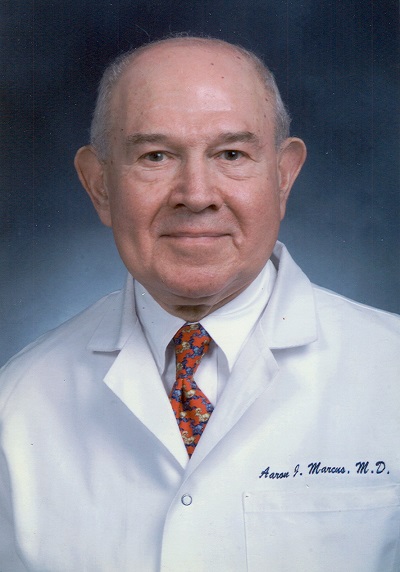Dr. Aaron J. Marcus died quietly in his sleep on May 6. Even at 89, he remained active in hematology research, directing experiments from his bedside until the very end.
Prior to entering the military in 1944, Dr. Marcus intended to be a lawyer. For bureaucratic reasons known only to the U.S. Navy, he was anointed a Pharmacist’s Mate Third Class and assigned to a naval hospital in California. There he tended to the sick, emptied bedpans, pondered scientific riddles, and found his vocation.
He obtained his M.D. from New York Medical College in 1953 and spent his residency and a research fellowship in hematology at Montefiore Hospital. Already, he was zooming in on the mysteries of thrombosis that would occupy him for the rest of his long career, publishing “Platelet Phosphatides: Their Separation, Identification, and Clotting Activity” in the Journal of Clinical Investigation in 1958. The role of platelet lipids in thrombosis remained the focus of his research for several decades, and he was among the first to demonstrate how platelets were affected by aspirin. He also invented the partial thromboplastin time test, still used widely for evaluating blood coagulation in patients.
These studies took place in a narrow, instrument-crammed laboratory at the VA New York Harbor Healthcare System, where he became Chief of Hematology-Oncology in 1958. In 1973, he was appointed Professor of Medicine at Weill Cornell Medical College and joined its Specialized Center of Research in thrombosis.
His immersion in platelet biology led Dr. Marcus to vascular eicosanoids and then to eicosanoid mediation of platelet-endothelial cell interactions. He created a new discipline that he called “transcellular metabolism.” “We now call this ‘systems biology’ and consider it a cutting-edge approach to scientific discovery,” notes Dr. Roy Silverstein, who worked with Dr. Marcus early in his career.
By the early 1990s, Dr. Marcus’s focus had shifted to an enzyme on the surface of endothelial cells that he and his team—including longtime colleagues Drs. Joan Drosopoulos and Johan Broekman—identified as CD39/NTPDase1. CD39 rapidly metabolized ADP and ATP released from activated platelets, and Dr. Marcus soon proposed that it represented the main control system for blood fluidity. His subsequent studies explored its antithrombotic, anti-inflammatory, and cardioprotective effects. In a final paper published this year (FASEB J. 2015;29:61-69), Dr. Marcus demonstrated how CD39 in cardiac nerve terminals modulated local renin release, angiotensin formation, and ischemic arrhythmias. “It was a privilege to share authorship on Aaron’s very last papers,” remembers Dr. Roberto Levi, a longtime colleague at Weill Cornell.
As a scientific investigator, Dr. Marcus was notable for his sheer longevity and unquenchable curiosity — he was the longest continuously funded National Institutes of Health grantee, and garnered a new 10-year National Heart, Lung, and Blood Institute MERIT award at age 80. “He lived and breathed hemostasis,” recalls Dr. Ralph L. Nachman, another comrade-in-arms. “He was on a constant search for new therapeutic agents designed to combat human thrombotic disease.” Dr. Marcus also took the role of mentor very seriously. In fact, he considered it a crucial part of his job. “He had a natural penchant for training generations of eager young investigators,” say close friends and Weill Cornell colleagues Drs. Katherine Hajjar and David Hajjar. Dr. Charles Serhan (Brigham and Women’s Hospital), who worked in Dr. Marcus’s lab as a graduate student, concurs: “His curiosity was infectious and his talent for zeroing in on the most critical and burning questions was unusual, and one of the most important for an effective mentor.” Dr. Andrew Schafer, former colleague and ASH past president, adds, “Aaron was one of my most influential mentors and a firm believer that being a mentor and being a mentee were lifetime responsibilities.”
Among his many honors, Dr. Marcus received the Henry Stratton Lectureship and “Pioneer in Hematology” award from ASH; the 1994 Bristol-Myers Squibb Award for Distinguished Achievement in Cardiovascular Research; and Special Service Awards from the Veterans Administration for 55 years of service.
A kind and endearingly quirky man, Dr. Marcus had many nonscientific passions. “Aaron possessed an amazing capacity to remember fascinating details and spin them into interesting stories,” recalls Dr. Silverstein. “He was a fountain of quotable sound bites. We talked about music, theater, literature, family, science, and people. There were never shades of gray in his opinions, but there were always provocative and challenging ideas.” Dr. Nachman similarly commends his old colleague’s “spontaneous humor and warm friendship,” and the “jazz and operatic pearls that poured from his 10-foot stereo speakers” on convivial occasions. “We shared a dual reverence for Arturo Toscanini,” says Dr. Levi, and indeed, one of Dr. Marcus’s prized possessions was an inscribed photo of the maestro. But when it came to Dr. Marcus’s insistence that Luciano Pavarotti was merely “yodeling” during the late phase of his career, the two opera buffs agreed to disagree.
Editor's Note: The 2015 Wallace H. Coulter Award for Lifetime Achievement in Hematology will recognize Aaron Marcus, MD, of Weill Cornell Medical College in New York. Dr. Marcus will be honored for seminal contributions to the field that spanned more than five decades and exemplified excellence in research, clinical care, and education.
Competing Interests
Dr. Weksler and Mr. Marcus have no relevant conflicts of interest. Mr. Marcus is Dr. Marcus's son.

